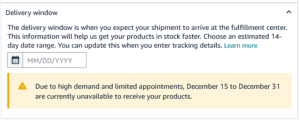The issue of Amazon warehouse overload has become an increasingly severe challenge for sellers, especially as the peak season approaches. Inventory management and shipping arrangements face significant pressure during this period.
Recently, many Amazon US sellers reported encountering a notification when creating shipments and inputting the estimated delivery date in the system. The message states: “Due to high demand and limited appointments, we are currently unable to receive shipments from December 15 to December 31.”
This announcement has left many sellers deeply concerned.

The Impact of the Halt on Sellers
This restriction means that new inventory cannot be checked in and listed for sale during this timeframe, which is a significant blow for sellers relying on Amazon’s Fulfillment by Amazon (FBA) service.
Insufficient inventory can lead to missed sales opportunities, increased buyer dissatisfaction, higher complaint and return rates, and, consequently, negative impacts on a seller’s overall ratings. These factors may further reduce future traffic and sales potential.
Not All Sellers Are Affected
Despite the notification, not all sellers will encounter the restriction when creating shipments. Some have reported successfully creating shipments and dispatching their goods without issues. Additionally, not all warehouses display this notification; certain facilities are still accepting shipments as usual.
This suggests that warehouse closures are “dynamic,” varying based on the real-time capacity and demand of individual warehouses. Sellers may experience different results when attempting to create shipments on different days or at different times.
For example, one seller shared that while they couldn’t select any warehouse (West Coast, East Coast, or Midwest) on the first day, they managed to create a shipment successfully the next day. This indicates that Amazon adjusts warehouse receiving statuses based on current inventory levels and capacity.
Do In-Transit Shipments Face Any Impact?
According to Amazon customer support, shipments already en route to a warehouse will not be affected by this restriction and will be received as usual.
However, sellers should be aware of two potential issues:
- Extremely slow check-in and listing times.
- Possible storage defect fees for delays or issues during check-in.
Additionally, altering the estimated delivery date for shipments may also face certain restrictions. Amazon advises sellers to try sending shipments outside of the restricted timeframes if possible.
How Can Sellers Respond to This Situation?
Here are some proactive steps sellers can take:
- Plan Shipments Early
Adjust your shipping schedule to ensure goods reach the warehouse by December 15, allowing products to be listed and sold promptly. - Diversify Inventory
Spread your inventory across multiple warehouses to mitigate the risks of a single warehouse refusing shipments or experiencing delays. This ensures operational continuity even if one warehouse encounters issues. - Monitor Amazon Notifications
Regularly check Amazon’s system notifications for updates on warehouse receiving statuses. Staying informed allows sellers to make timely adjustments to their plans. - Consult Amazon Customer Support
If you experience issues creating or sending shipments, contact Amazon customer support to verify the reasons and obtain the latest updates on warehouse receiving statuses.
While the temporary halt on receiving shipments at certain Amazon warehouses poses challenges, proactive planning and effective communication with Amazon can help mitigate the impact on your business.


